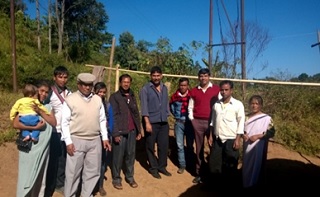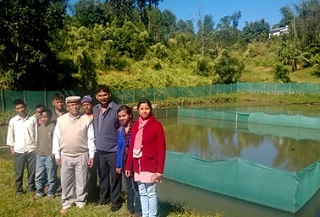Field visit cum interaction with villagers under MeraGaonMera Gaurav programme.
The visionary programme of Hon’ble Prime Minister of India “Mera Gaon Mera Gaurav” (My village, My pride) was organized by Team XI (Dr. S. K. Das, Group Leader, Dr. Jayanta Layek, Dr. Amrita Banerjee, Dr. Rajappa and Ms. Piyashi DebRoy) ICAR Research Complex for NEH Region, Umiam. The villages selected for the programme are Mawlwai, Sohriewblei, Umraling, Khapmara and Lumsohpieng. These villages are situated within Ri-Bhoi district, Meghalaya. The team made the visit on 24 November 2015 to two of the selected namely Sohriewblei and Umraling. The post office for both the villages is Kyrdem within Umsning Block of the Ri-Bhoi district.The village Sohriewblei is located at a distance of 22 km from the ICAR RC for NEH Region, Umiam. The total number of farm families including landless involved in farming is 102. The village Umraling is located at a distance of 26 km from the ICAR RC for NEH Region, Umiam. The total number of farm families including landless involved in farming are 100. All the farm families fall under the Scheduled Tribe Category. The Headman of the village Sohriewblei Mr. P.D. Wanbah and village Umraling, Mr. Mathias Mynsong initiated the interaction of the villagers present there with us. From the interaction with villagers, it was learnt that most of the farmers are very small and marginal in nature. The topography of the villages are general is hilly. About 80-85% of the area of the village can be categorized as upland while remaining 10-15% can be categorized as valley land. The cropping intensity in the village is about 110-115 %. Very few area of the valley land has the facility of providing irrigation. The prevalent food crops/spices/cash crops of the village are rice, maize, broom grass, ginger, turmeric, pineapple, banana, French bean and vegetables such as colocasia, chilli, pumpkin, brinjal, bottle gourd and tomato. Rice is grown in maximum area in valley land and the varieties grown are local and low yielding (Mendri, Manipuri, Kyrdut, Lehriy, Lakang and Eithati). The productivity of paddy here is 2.0 to 2.4 tons per ha. The major problems encountered in paddy cultivation are the diseases caused by stem borer and blast. Ginger is cultivated in a total area of 20 ha. Locally available varieties are used for farming. The productivity of ginger is 70 to 80 quintal per ha. The disease generally encountered in ginger cultivation is soft rot. In livestock, the major categories maintained by the villagers are pig and poultry. Most of the areas after rice harvest is left fallow except some for vegetable cultivation. More than half of the farming community have some type of animal mainly as pig and poultry as integrated part of farming system. Most of the breeds of pigs are of local types with adults weighing around 40 to 50 kg. Vaccination is also occasionally provided to the pigs. Farmers reared local poultry birds as a backyard basis. Very few famers reared cattle. There are about 12-14 fish ponds each in the villages with an average area of 0.05 ha each. The major fish species cultivated in the villages are grass carp, silver carp and amur carp and productivity is very less. A unique feature of farming in the village is no fungicides or insecticides are used. Except for fertilizers used for vegetable crops, the farming practices are all organic. The main problem faced in fish health management is necrosis. In agriculture, the major problems are irrigation, lack of high yielding variety (HYV) seeds and also lack of proper training in following scientific management principles of farming practices. At the meeting with the villagers, the plan of work under Mera Gaon Mera Gaurav was discussed and every possible help from ICAR side was assured. The farmers were assured about supply of various inputs like seeds of improved crop varieties, vegetables, small farm implements, fingerlings, organic plant protecting chemical etc. It was also discussed that suitable training and awareness programmee for following scientific practices for agriculture and allied activities would be organized for the farmers. The farmers were urged to interact with scientists and other staffs of ICAR Umiam for problems associated with their day to day problem related to agriculture and allied activities.

